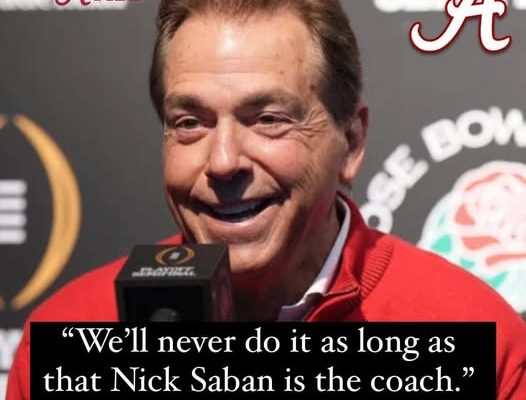When people look back at the legacy of Nick Saban and his time at Alabama, there are countless defining moments that shaped the dynasty he went on to build. Some of those moments happened under the bright lights on Saturdays, in championship games, and in recruiting battles that shifted the balance of power in college football. But just as important are the quieter, more personal moments that carry symbolic weight—moments that reflect not just what Saban accomplished, but who he was in the process of doing it. One such moment came in 2007, after Alabama had suffered one of its most humiliating defeats of the modern era, a shocking 21–14 loss at home to Louisiana Monroe. At that point in his career in Tuscaloosa, Saban was still a new hire, a man with national championship credentials from LSU but surrounded by questions about whether he could recreate that success at Alabama, a program that had stumbled through inconsistency and disappointment for over a decade. The idea that Alabama would someday rule college football again was not something most people believed that night. And yet, it was in that low point, on the side of the road at a gas station, that Nick Saban revealed the unshakable confidence that would eventually define Alabama’s return to glory.
The story goes that after the shocking loss to Louisiana Monroe in 2007, Saban stopped for gas on his way home. For any coach, especially one known for his meticulous preparation and high standards, such a defeat would have felt like an embarrassment, a painful reminder of how far the program had to go. Alabama fans had expected Saban to bring immediate results, and instead, here was a loss to a Sun Belt team that many fans probably couldn’t have found on a map. The defeat made national headlines, not just because it was a huge upset, but because it felt like proof to skeptics that Alabama might not be fixable, no matter who was in charge. Saban, however, saw it differently. When he walked into the gas station to pay for fuel, the cashier noticed the ring on his finger and asked him about it. That ring was his LSU national championship ring, a tangible piece of evidence of his ability to build a winner. Without hesitation, Saban told the cashier: “That’s a National Championship ring from LSU, and we’re going to do the same thing here at Alabama.”
What makes this moment remarkable is not just the confidence of the statement, but the context. At that time, Alabama was nowhere near a championship contender. They had just lost to a team they were supposed to beat easily, and in the broader college football world, Alabama was still seen as a relic of the past, a program with history and tradition but not much to show in the present. Saban’s words could have come off as arrogance, but instead, they were a reflection of the vision he carried with him from the moment he arrived in Tuscaloosa. He believed in the process, the culture he was implementing, and the idea that success would follow if the right steps were taken, no matter how bleak things might look in the short term. That ring on his finger wasn’t just jewelry—it was proof that his way of doing things worked, and it was a promise that Alabama would one day wear rings of their own.
For Alabama fans, that memory now reads like foreshadowing of the dynasty to come. Within just a couple of years, Saban had built Alabama into a powerhouse. In 2009, only two years after the loss to Louisiana Monroe, Alabama went 14–0 and won the BCS National Championship against Texas. That team was tough, disciplined, and built in the exact image of Saban’s philosophy. From that point forward, Alabama football became synonymous with dominance, collecting national championships at a rate unmatched in the modern game. The gas station story serves as a kind of origin myth for the dynasty, a reminder that the greatness fans would come to expect was born out of confidence and belief in the process during the darkest of days.
It also speaks to something deeper about leadership and resilience. In sports, as in life, the measure of a leader is not how they act when everything is going well, but how they respond when things go wrong. For many coaches, a loss like the one to Louisiana Monroe would have been a blow to their credibility, something they tried to hide or brush off. But Saban turned it into a moment of defiance, of planting a flag in the ground and declaring that the future would not be defined by temporary setbacks. That statement to the cashier was not for show—it was the exact same message he was giving to his players and staff behind closed doors. Don’t focus on the embarrassment of the loss. Focus on the bigger picture. Stick to the process. Rings will come.
The symbolism of the ring is important too. A championship ring is not just a trophy. It’s a permanent reminder of what it takes to win at the highest level: the countless hours of preparation, the grueling practices, the discipline, the willingness to sacrifice. By wearing it on his finger and pointing to it in that gas station, Saban was showing that he wasn’t just talking about success—he had lived it, and he intended to live it again. To the casual observer that night, it may have just been an offhand comment. But in hindsight, it was the encapsulation of the Saban era at Alabama: a declaration that no matter what the scoreboard said, the standard was the standard, and Alabama would reach it.
Over time, Alabama’s dynasty validated every word of that moment. Multiple national championships followed: 2009, 2011, 2012, 2015, 2017, and 2020. Dozens of players went on to the NFL, many becoming stars, and Alabama became a factory for not just talent, but also for the culture of excellence Saban preached. Every step of the way, the program operated with the same mentality that Saban carried with him into that gas station: we know where we’re going, and temporary setbacks won’t derail us. That kind of consistency is rare in sports, where emotions often swing wildly from week to week, but it’s what made Alabama different under Saban.
In a way, the Louisiana Monroe loss was necessary for the dynasty to be what it became. It served as a wake-up call for players and fans who may have assumed success would come quickly. It exposed the cracks in the team’s mindset and forced everyone to buy into Saban’s process completely. By the time Alabama was lifting the national championship trophy in Pasadena after the 2009 season, that gas station story was already part of the program’s lore. It illustrated just how far Alabama had come in such a short time, and it gave fans a narrative to hold onto: even when things seemed hopeless, Saban already knew where the journey was headed.
The story also resonates because it humanizes Saban. He’s often portrayed as a perfectionist, a football machine who cares only about the next play or the next practice. But this moment shows a more personal side—the man standing in a gas station after a tough loss, engaging in small talk with a cashier who had no idea she was part of college football history in the making. It reminds us that even the most legendary figures have moments of doubt and frustration, and that greatness often reveals itself in the most ordinary of places.
Today, when Alabama fans tell the story of Nick Saban, they don’t just talk about the national titles and the Heisman winners. They also talk about the Louisiana Monroe loss, because it represents the turning point when faith was tested and the foundation was laid. Without that loss, the gas station story never happens. Without that story, we lose a key piece of the mythology that makes Alabama’s dominance so powerful. It is proof that belief and vision can turn even the lowest points into stepping stones toward greatness.
For the cashier that night, it was probably just a brief conversation, the kind of thing that might have been forgotten as soon as the next customer walked in. For Saban, it was a reaffirmation of what he already knew. For Alabama football, it was the beginning of a promise that would be fulfilled many times over. And for college football fans everywhere, it stands as a lesson in resilience: sometimes the path to greatness runs through moments of failure, and sometimes the most important statements are made not in press conferences or locker rooms, but in small gas stations on dark nights, when the future seems uncertain but the vision remains crystal clear.
In the end, that gas station stop in 2007 wasn’t just about paying for fuel. It was about fueling a belief, a dynasty, and a legacy that would forever change the landscape of college football. The LSU championship ring on Nick Saban’s finger that night was more than jewelry—it was a promise. And in the years that followed, he kept that promise again and again, until Alabama football became the standard by which all others were measured.



